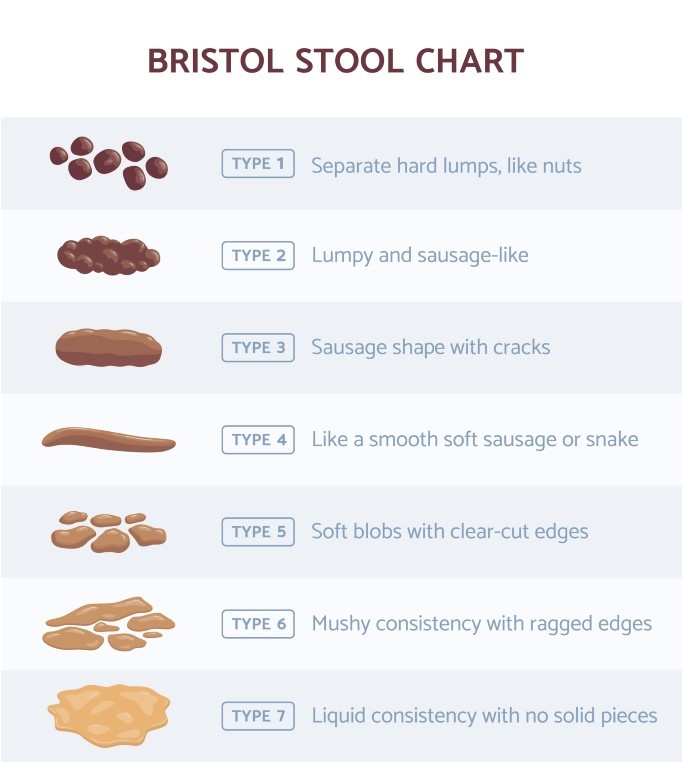Alternatives to colonoscopy may help beat "fear of the rear"
Posted September 14, 2015
Continue reading this article
CARE
Posted March 21, 2025
We all poop. Still, it can be a little embarrassing to talk about it. But you should bring it up with your doctor if your bathroom routine or stool changes in an unusual way.
It can be a signal that you’re not drinking enough water, not eating enough fiber-rich foods or that something even more serious is happening.
Nature calls for many people every morning, but when and how often you have a bowel movement can vary. During a bathroom break, you should be able to pass stools within a few minutes and without pain.
A normal bowel movement looks like the poop emoji you see in a text. It is a medium to dark brown cylinder-shaped stool that stays intact when flushed.
An unpleasing odor is typical, but poop shouldn’t make your eyes water. An intense, foul smell can be caused by an internal infection or your body’s inability to process certain nutrients.
Your stool is mostly water, undigested food and dead bacteria. A combination of stomach bile and bilirubin, which forms when red blood cells break down, gives your waste its color and look. How slowly or quickly waste moves through your system can affect the color and consistency of what you see during a bathroom break. A stool that isn’t the typical brownish color could be easy to explain. However, if it shows up for a few trips to the bathroom, it could be a reason to check with your doctor.
A red stool might be as simple as having eaten a red-colored food like beets. It can also be caused by menstruation, hemorrhoids or constipation. At its most serious, a red stool can be a symptom of inflammation or an infection in your lower gastrointestinal (GI) tract, bowels or stomach.
If your stool is black, it may also be connected to food, like a recent snack of black licorice or blueberries. A black stool could be a side effect of taking an iron supplement. However, black stool can also signal bleeding or tumors in your intestinal tract. If you have an unexplained black stool, you should see a doctor.
A light-colored stool with a yellow tint can mean that you’re eating too much fat. But it can also be a sign that there’s an issue with your liver, pancreas or gallbladder being able to get nutrients from digestion.
Green poop can mean you’re getting lots of leafy vegetables like spinach, which is part of a healthy diet. On the other hand, artificial colors in processed foods and drinks can also turn your stool green. This color can also be a signal that your food isn’t moving too quickly through your digestive system.
A chalky look to stool might be caused by medicine, including one used for treating diarrhea. But a gray or white color can also mean that there’s something wrong with your body’s bile production or the duct where bile is stored.
Most people poop every 1 to 3 days. Others may go No. 2 a few times a day. Instead of focusing on how often you poop, pay attention to what is normal for you — that includes occasional bouts of diarrhea or constipation.
If the color, shape or texture of your stool changes drastically and remains that way, it could mean something’s not right.
If any of these symptoms last for more than a few days, it can indicate something’s wrong:
A primary care doctor can help with questions about these symptoms. Your doctor may also refer you to a gastroenterologist, a medical specialist who focuses on the diagnosis, treatment, and prevention of disorders affecting the GI tract. This includes the stomach, liver, small intestine, large intestine and rectum.
Doctors use the Bristol Stool Form Scale to help identify stool variations. The chart’s seven categories range from hard stools to soft, loose stools. The chart also identifies the color and consistency of poop. The chart can be broken into three main categories:
These are represented in types 1 and 2 on the chart. They are too hard and dry, making them difficult to pass. These stools can be a sign of constipation.
These examples are types 3 and 4 on the chart. They pass easily and hold their shape when flushed. They are normal, healthy stools.
Types 5, 6 and 7 on the chart show loose stools. They consist of soft materials that don’t hold together. These stools can indicate a lack of fiber in a diet or an underlying bowel problem.
It can be helpful to review the stool chart before seeing your doctor, so you accurately describe your issue.

Bristol Stool Chart
A healthy lifestyle can make it easier to ensure your No. 2s are no big deal. Here are some tips to keep your digestive system running smoothly:
Consult a primary care doctor
Make appointmentLearn about healthy eating from a dietitian
Make appointmentGet a colonoscopy near you
Schedule nowPosted September 14, 2015
Continue reading this articleGet fun, inspiring, provider-reviewed articles sent to your inbox.
Sign up for our email newsletter